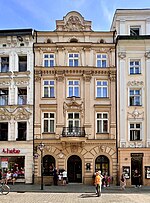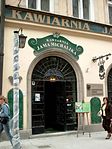Floriańska Street
13th-century establishments in PolandStreets in KrakówTourist attractions in Kraków

Floriańska Street or St. Florian's Street (Polish: ulica Floriańska, Latin: platea Sancti Floriani) is one of the main streets in Kraków Old Town and one of the most famous promenades in the city. The street forms part of the regular grid plan of Stare Miasto (the Old Town), the merchants' town that extends the medieval heart of the city, which was drawn up in 1257 after the destruction of the city during the first Mongol invasion of Poland of 1241.
Excerpt from the Wikipedia article Floriańska Street (License: CC BY-SA 3.0, Authors, Images).Floriańska Street
Floriańska, Krakow Stare Miasto (Old Town)
Geographical coordinates (GPS) Address Nearby Places Show on map
Geographical coordinates (GPS)
| Latitude | Longitude |
|---|---|
| N 50.0633 ° | E 19.9402 ° |
Address
Floriańska 25
31-019 Krakow, Stare Miasto (Old Town)
Lesser Poland Voivodeship, Poland
Open on Google Maps










